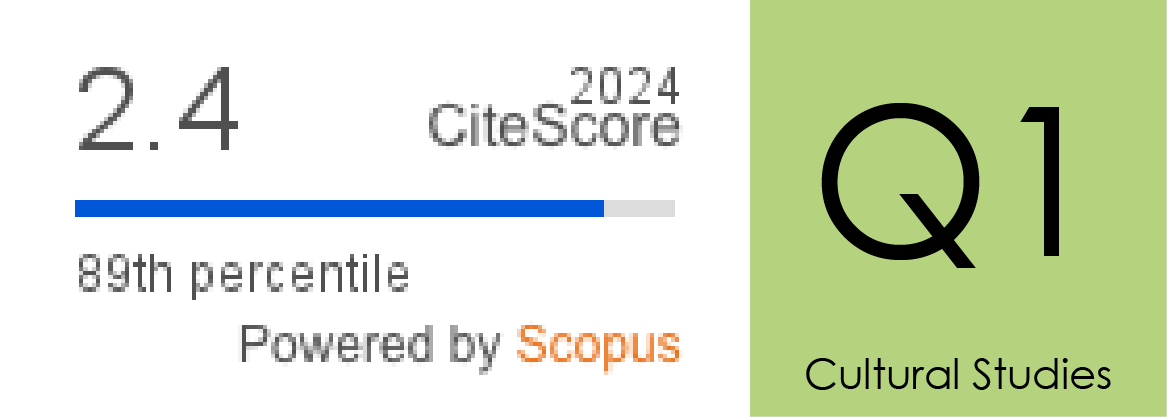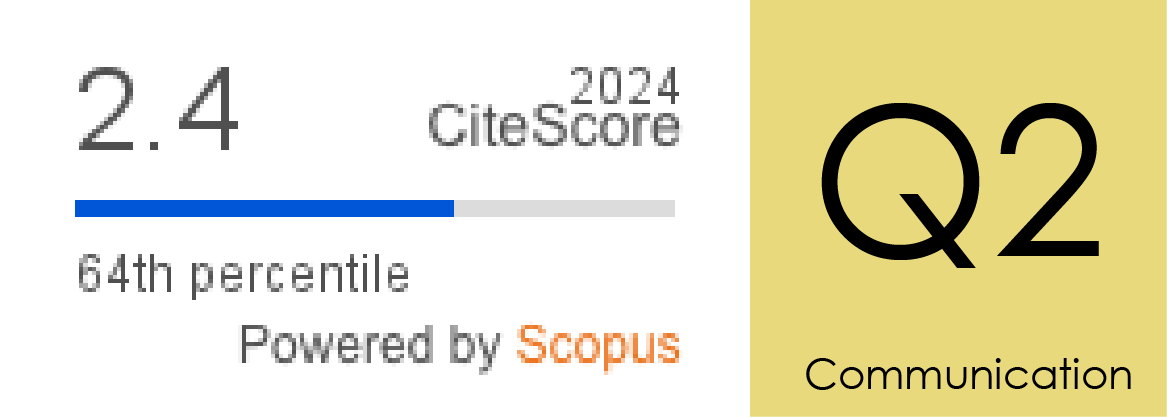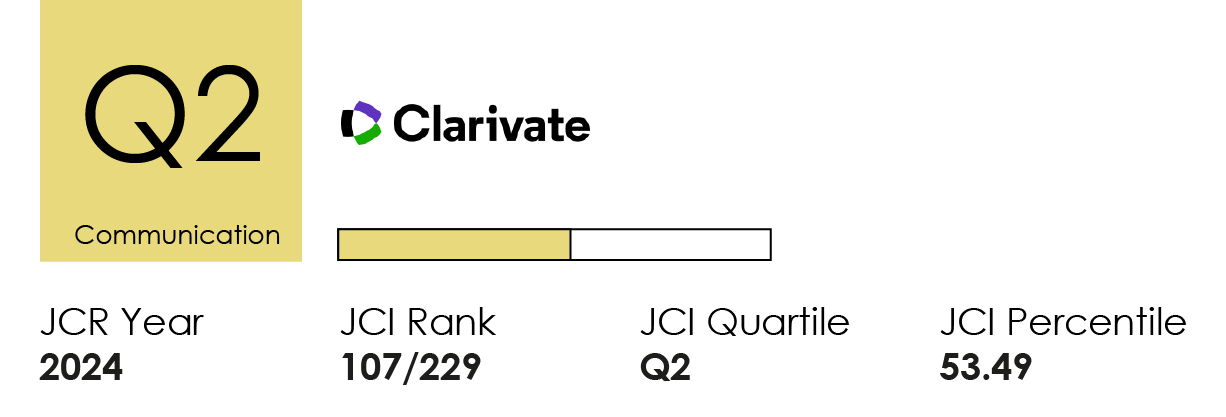Satisfacción corporal y uso de pantallas en escolares españoles
DOI:
https://doi.org/10.14198/MEDCOM.23406Palabras clave:
Audiencia infantil, imagen corporal, medios digitales, percepción corporal, psicología de los medios, satisfacción corporalResumen
El uso de pantallas entre los menores ha aumentado drásticamente en los últimos años. Aunque el consumo mediático es considerado un factor influyente en la satisfacción corporal infantil, la relación entre el consumo de pantallas y la satisfacción corporal en menores de diez años es un tema aún poco explorado. Se diseñó un estudio transversal con una muestra de 792 estudiantes (N = 363 niños, 429 niñas, M = 7.23 años) para analizar la asociación entre el uso de pantallas y la satisfacción corporal en niños y niñas de 5 a 9 años. Los resultados muestran relaciones entre el consumo de televisión y videojuegos y la satisfacción de rasgos faciales y esquema corporal global. Las observaciones por sexo indicaron correlaciones positivas para el consumo de televisión y la satisfacción con el peso entre los varones mientras que en las niñas se observó una asociación negativa para el consumo de videojuegos y la satisfacción de la piel y el esquema corporal global. Los análisis de regresión múltiple revelaron una asociación positiva para el consumo de televisión con la satisfacción con el peso, la cara y el cabello; por su parte, el uso de videojuegos se asoció negativamente con la satisfacción con el color de los ojos y la piel. Este estudio aporta un mayor conocimiento sobre la relación entre consumo de pantallas y satisfacción corporal infantil y puede contribuir al diseño de intervenciones de alfabetización mediática más estratégicas y focalizadas, sobre todo entre aquellas poblaciones menos exploradas como la audiencia infantil.Financiación
Ministerio de Economía y Competitividad, España (CSO2014-58220-R) y ayuda FPI MINECO (BES-2015-071228).Citas
Asociación para la Investigación de Medios de la Comunicación [AIMC]. (Ed.) (2019). Marco General de los Medios en España 2019. https://bit.ly/2U5d36q
Amado Alonso, D., León-Del-Barco, B., Mendo-Lázaro, S., & Iglesias Gallego, D. (2020). Examining Body Satisfaction and Emotional–Social Intelligence among School Children: Educational Implications. International journal of environmental research and public health, 17(6), 2120. https://doi.org/10.3390/ijerph17062120
Anschutz, D. J., Engels, R. C., & Van Strien, T. (2012). Increased body satisfaction after exposure to thin-ideal children's television in young girls showing thin ideal internalisation. Psychology & Health, 27(5), 603-617. https://doi.org/10.1080/08870446.2011.613470
Añez, E., Fornieles-Deu, A., Fauquet-Ars, J., López-Guimerà, G., Puntí-Vidal, J., & Sánchez-Carracedo, D. (2018). Body image dissatisfaction, physical activity and screen-time in Spanish adolescents. Journal of Health Psychology, 23(1), 36–47. https://doi.org/10.1177/1359105316664134
Barlett, C., & Harris, R. (2008). The impact of body emphasizing video games on body image concerns in men and women. Sex Roles, 59(7-8), 586-601. https://doi.org/10.1007/s11199-008-9457-8
Brito, R., Dias, P., & Oliveira, G. (2018). Young children, digital media and smart toys: How perceptions shape adoption and domestication. British Journal of Educational Technology, 49(5), 807–820. https://doi.org/10.1111/bjet.12655
Cash, T., & Smolak, L. (2011). Body image: A handbook of science, practice, and prevention. Guilford Press.
Castelló-Martínez, A., & Tur-Viñes, V. (2020). Obesity and food-related content aimed at children on YouTube. Clinical Obesity, 10(5). https://doi.org/10.1111/cob.12389
Cernikova, M., Smahel, D., & Wright, M. (2017). Children’s Experiences and Awareness about Impact of Digital Media on Health. Health Communication, 33(6), 1–10. https://doi.org/10.1080/10410236.2017.1298197
Chaudron, S. (2015). Young children (0-8) and digital technology. A qualitative exploratory study across seven countries. European Commission Joint Research Centre. https://bit.ly/3dgut7R
Costa, L., Silva, D. A., Alvarenga, M., & de Vasconcelos, F. (2016). Association between body image dissatisfaction and obesity among schoolchildren aged 7–10 years. Physicology & Behavior, 160, 6–11. https://doi.org/10.1016/J.PHYSBEH.2016.03.022
Daraganova, G. (2014). Body image of primary school children. Annual Statistical Report 2013. Australian Institute of Families Studies. AIFS. https://bit.ly/3QN8mc4
Damiano, S. R., Hart, L., Paxton, S. J., Cornell, C., & Sutherland, F. (2014). Are body image and eating attitudes, behaviours, and knowledge of parents of pre-schoolers associated with parent feeding practices? Journal of Eating Disorders, 2(1), 1-1. https://doi.org/10.1186/2050-2974-2-S1-O34
Duchin, O., Marin, C., Mora-Plazas, M., Mendes de Leon, C., Lee, J. M., Baylin, A., & Villamor, E. (2015). A prospective study of body image dissatisfaction and BMI change in school-age children. Public Health Nutrition, 18(2), 322–328. https://doi.org/10.1017/S1368980014000366
Dumas, A., & Desroches, S. (2019). Women’s Use of Social Media: What Is the Evidence About Their Impact on Weight Management and Body Image? Current Obesity Reports, 8(1), 18–32. https://doi.org/10.1007/s13679-019-0324-4
Eyal, K., & Te’eni-Harari, T. (2013). Explaining the relationship between media exposure and early adolescents’ body image perceptions: The role of favorite characters. Journal of Media Psychology, 25(3), 129–141. https://doi.org/10.1027/1864-1105/a000094
Fisher-Keller, J. (2007). How Do Kids’ Self-Identities Relate to Media Experiences in Everyday Life? In S. Mazzarella (Ed.), 20 Questions about Youth & the Media (pp. 225-237). Peter Lang.
Grogan, S. (2016). Body image: Understanding body dissatisfaction in men, women and children. Routledge. https://doi.org/10.4324/9781315681528
Haddad, C., Zakhour, M., Akel, M., Honein, K., Akiki, M., Hallit, S., & Obeid, S. (2019). Factors associated with body dissatisfaction among the Lebanese population. Eating and weight disorders-studies on anorexia, bulimia and obesity, 24(3), 507-519. https://doi.org/10.1007/s40519-018-00634-z
Hall, L., Hume, C., & Tazzyman, S. (2016, June). Five degrees of happiness: Effective smiley face likert scales for evaluating with children. In Proceedings of the the 15th international conference on interaction design and children (pp. 311-321). https://doi.org/10.1145/2930674.2930719
Heidelberger, L., & Smith, C. (2018). Low-Income, African American and American Indian children’s viewpoints on body image assessment tools and body satisfaction: A mixed methods study. Maternal and child health journal, 22(9), 1327-1338. https://doi.org/10.1007/s10995-018-2513-2
Jarman, H. K., McLean, S. A., Slater, A., Marques, M. D., & Paxton, S. J. (2021). Direct and indirect relationships between social media use and body satisfaction: A prospective study among adolescent boys and girls. New Media & Society. https://doi.org/10.1177/14614448211058468
Jordan-Jackson, F., Chapa, S., Lee, J., & Davis, K. (2019). The role of ethnicity in the relationship between media exposure and female body dissatisfaction. Journal of Cultural Marketing Strategy, 3(2), 131-151. https://bit.ly/3A3PChV
Kantar Media. (2021). Media Trends and Predictions Report ES. Kantar Global. https://bit.ly/3QSc7x2
Kelly, Y., Zilanawala, A., Booker, C., & Sacker, A. (2018). Social media use and adolescent mental health: Findings from the UK Millennium Cohort Study. EClinicalMedicine, 6, 59-68. https://doi.org/10.1016/j.eclinm.2018.12.005
Latiff, A., Muhamad, J., & Rahman, R. (2018). Body image dissatisfaction and its determinants among young primary-school adolescents. Journal of Taibah University Medical Sciences, 13(1), 34–41. https://doi.org/10.1016/j.jtumed.2017.07.003
Lemes, D. C.; Gonçalves-Câmara, S., Guimares-Alves, G., & Aerts, D. (2018). Body image satisfaction and subjective wellbeing among ninth-grade students attending state schools in Canoas, Brazil. Ciencia & saude coletiva, 23, 4289-4298. https://doi.org/10.1590/1413-812320182312.14742016
López Sánchez, G. F., Suárez, A. D., & Smith, L. (2018). Análisis de imagen corporal y obesidad mediante las siluetas de Stunkard en niños y adolescentes españoles de 3 a 18 años. Anales de Psicología/Annals of Psychology, 34(1), 167-172. https://doi.org/10.6018/analesps.34.1.294781
Núñez-Gómez, P., Ortega-Mohedano, F., & Larrañaga-Martínez, K. (2021). Hábitos de uso y consumo de pantallas inteligentes entre niños/as de 7 a 9 años en España. Revista Mediterránea de Comunicación, 12(1), 191-204. https://doi.org/10.14198/MEDCOM000009
Penelo, E., Espinoza, P., Portell, M., & Raich, R. (2012). Assessment of body image: Psychometric properties of the Body Image Questionnaire. Journal of Health Psychology, 17(4), 556-566. https://doi.org/10.1177/1359105311417913
Qustodio (2022). The Qustodio Annual Data Report 2021: Living and learning in a digital world. https://bit.ly/3xZ4Nsw
Reid Chassiakos Y., Radesky J., Christakis D., Moreno M., Cross C., Council On Communications and Media, Hill, D., Ameenudin, N., Hutchinson, J., Levine, A., Boyd, A., Mendelson, R., Swanson, W. (2016). Children and Adolescents and Digital Media. Pediatrics. 138(5). https://doi.org/10.1542/peds.2016-2593
Richards, D., Caldwell, P. H., & Go, H. (2015). Impact of social media on the health of children and young people. Journal of paediatrics and child health, 51(12), 1152-1157. https://doi.org/10.1111/jpc.13023
Rodgers, R. F., Wertheim, E. H., Damiano, S. R., & Paxton, S. J. (2020). Maternal influences on body image and eating concerns among 7 and 8-year-old boys and girls: Cross-sectional and prospective relations. International Journal of Eating Disorders, 53(1), 79-84. https://doi.org/10.1002/eat.23166
Sánchez Castillo, S., Sánchez, G. F. L., Ahmed, M. D., & Suárez, A. D. (2019). Imagen Corporal y Obesidad mediante las Siluetas de Stunkard en Niños y adolescentes indios de 8 a 15 años. Cuadernos de Psicología del Deporte, 19(1), 19-31. https://doi.org/10.6018/cpd.335621
Sánchez-Zafra, M., Zurita-Ortega, F., Ramírez-Granizo, I., Puertas-Molero, P., González-Valero, G., & Ubago-Jiménez, J. (2019). Niveles de autoconcepto y su relación con el uso de videojuegos en escolares de tercer ciclo de primaria. Journal of Sport & Health Research, 11(1). https://bit.ly/3ppnLn8
Smolak, L. (2004). Body image in children and adolescents: where do we go from here? Body image, 1(1), 15-28. https://doi.org/10.1016/S1740-1445(03)00008-1
Spurr, S., Berry, L., & Walker, K. (2013). Exploring adolescent views of body image: The influence of media. Comprehensive Child and Adolescent Nursing, 36(1–2), 17–36. https://doi.org/10.3109/01460862.2013.776145
Sylvia, Z., King, T., & Morse, B. (2014). Virtual ideals: The effect of video game play on male body image. Computers in Human Behavior, 37, 183-188. https://doi.org/10.1016/j.chb.2014.04.029
Tatangelo, G., & Ricciardelli, L. (2017). Children’s body image and social comparisons with peers and the media. Journal of Health Psychology, 22(6), 776–787. https://doi.org/10.1177/1359105315615409
Uchôa, F., Uchôa, N. M., Daniele, T., Lustosa, R. P., Garrido, N. D., Deana, N. F., Aranha, Á., & Alves, N. (2019). Influence of the mass media and body dissatisfaction on the risk in adolescents of developing eating disorders. International journal of environmental research and public health, 16(9), 1508. https://doi.org/10.3390/ijerph16091508
Wartella, E. A., Lovato, S. B., Pila, S., Lauricella, A. R., Echevarria, R., Evans, J., & Hightower, B. (2018). Digital media use by young children: Learning, effects, and health outcomes. In Child and Adolescent Psychiatry and the Media (pp. 173-186). Elsevier. https://doi.org/10.1016/B978-0-323-54854-0.00016-3
Yang, J., Fardouly, J., Wang, Y., & Shi, W. (2020). Selfie-Viewing and Facial Dissatisfaction among Emerging Adults: A Moderated Mediation Model of Appearance Comparisons and Self-Objectification. International journal of environmental research and public health, 17(2), 672. https://doi.org/10.3390/ijerph17020672
Descargas
Estadísticas
Publicado
Cómo citar
Número
Sección
Licencia
Derechos de autor 2018 J Roberto Sánchez Reina, Mònika Jiménez-Morales, Mireia Montaña Blasco

Esta obra está bajo una licencia internacional Creative Commons Atribución 4.0.
Los autores y autoras que publican en esta revista están de acuerdo con los siguientes términos:
1 Derechos de autor. Los autores y autoras conservan sus derechos de autor, aunque ceden a la revista de forma no exclusiva los derechos de explotación (reproducción, distribución, comunicación pública y transformación) y garantizan a esta el derecho de primera publicación de su trabajo, el cual estará simultáneamente sujeto a la licencia indicada en punto 2. Los autores pueden establecer otros acuerdos adicionales para la distribución no exclusiva de la versión de la obra publicada en la revista, siempre que exista un reconocimiento de su publicación inicial en esta revista.
© Los autores.
2 Licencia. Los trabajos se publican en la revista sujetos a la licencia de Reconocimiento 4.0 Internacional de Creative Commons (CC BY 4.0); los términos se pueden consultar en https://creativecommons.org/licenses/by/4.0/
Esta licencia permite a terceros compartir (copiar y redistribuir el material en cualquier medio o formato) y adaptar (remezclar, transformar y crear a partir del material para cualquier finalidad, incluso comercial), siempre que se reconozca la autoría y la primera publicación en esta revista (Revista Mediterránea de Comunicación (RMC) / Mediterranean Journal of Communication (MJC), Universidad de Alicante, DOI de la obra), se proporcione un enlace a la licencia y se indique si se han realizado cambios en la obra.
3 Política de autoarchivo. Se recomienda a los autores que difundan sus trabajos a través de Internet para favorecer una circulación y difusión más rápidas y, con ello, un posible aumento en la citación y alcance entre la comunidad científica y académica, en las siguientes condiciones:
No se permite a los autores depositar en un repositorio institucional o temático, página web propia, etc., las versiones preprint (versión antes de ser evaluada) o postprint (versión evaluada y aceptada para su publicación) de sus trabajos antes de su publicación, pero sí el artículo final publicado (versión del editor).













